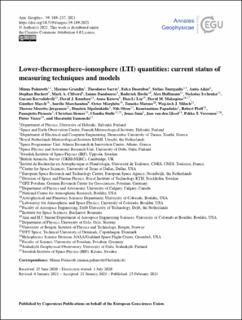| dc.contributor.author | Palmroth, Minna | |
| dc.contributor.author | Grandin, Maxime | |
| dc.contributor.author | Sarris, Theodoros E. | |
| dc.contributor.author | Doornbos, Eelco | |
| dc.contributor.author | Tourgaidis, Stylianos | |
| dc.contributor.author | Aikio, Anita | |
| dc.contributor.author | Buchert, Stephan C. | |
| dc.contributor.author | Clilverd, Mark A. | |
| dc.contributor.author | Dandouras, I | |
| dc.contributor.author | Heelis, Roderick A. | |
| dc.contributor.author | Hoffmann, A | |
| dc.contributor.author | Ivchenko, N. | |
| dc.contributor.author | Kervalishvili, G. | |
| dc.contributor.author | Knudsen, D. | |
| dc.contributor.author | Kotova, A | |
| dc.contributor.author | Liu, H.-L. | |
| dc.contributor.author | Malaspina, D | |
| dc.contributor.author | March, G. | |
| dc.contributor.author | Marchaudon, A | |
| dc.contributor.author | Marghitu, Octav | |
| dc.contributor.author | Matsuo, T | |
| dc.contributor.author | Miloch, Wojciech Jacek | |
| dc.contributor.author | Moretto, Therese | |
| dc.contributor.author | Mpaloukidis, D | |
| dc.contributor.author | Olsen, NIls | |
| dc.contributor.author | Pfaff, R. | |
| dc.contributor.author | Papadakis, K | |
| dc.contributor.author | Pirnaris, Panagiotis | |
| dc.contributor.author | Siemes, C. | |
| dc.contributor.author | Stolle, Claudia | |
| dc.contributor.author | Suni, J. | |
| dc.contributor.author | van den IJssel, J. | |
| dc.contributor.author | Verronen, Pekka T. | |
| dc.contributor.author | Visser, P. | |
| dc.contributor.author | Yamauchi, Masatoshi | |
| dc.date.accessioned | 2021-10-04T09:40:49Z | |
| dc.date.available | 2021-10-04T09:40:49Z | |
| dc.date.created | 2021-10-03T14:31:00Z | |
| dc.date.issued | 2021 | |
| dc.identifier.issn | 0992-7689 | |
| dc.identifier.uri | https://hdl.handle.net/11250/2787418 | |
| dc.description.abstract | The lower-thermosphere–ionosphere (LTI) system consists of the upper atmosphere and the lower part of the ionosphere and as such comprises a complex system coupled to both the atmosphere below and space above. The atmospheric part of the LTI is dominated by laws of continuum fluid dynamics and chemistry, while the ionosphere is a plasma system controlled by electromagnetic forces driven by the magnetosphere, the solar wind, as well as the wind dynamo. The LTI is hence a domain controlled by many different physical processes. However, systematic in situ measurements within this region are severely lacking, although the LTI is located only 80 to 200 km above the surface of our planet. This paper reviews the current state of the art in measuring the LTI, either in situ or by several different remote-sensing methods. We begin by outlining the open questions within the LTI requiring high-quality in situ measurements, before reviewing directly observable parameters and their most important derivatives. The motivation for this review has arisen from the recent retention of the Daedalus mission as one among three competing mission candidates within the European Space Agency (ESA) Earth Explorer 10 Programme. However, this paper intends to cover the LTI parameters such that it can be used as a background scientific reference for any mission targeting in situ observations of the LTI. | en_US |
| dc.language.iso | eng | en_US |
| dc.publisher | Copernicus | en_US |
| dc.rights | Navngivelse 4.0 Internasjonal | * |
| dc.rights.uri | http://creativecommons.org/licenses/by/4.0/deed.no | * |
| dc.title | Lower-thermosphere–ionosphere (LTI) quantities: current status of measuring techniques and models | en_US |
| dc.type | Journal article | en_US |
| dc.type | Peer reviewed | en_US |
| dc.description.version | publishedVersion | en_US |
| dc.rights.holder | Copyright 2021 the authors | en_US |
| cristin.ispublished | true | |
| cristin.fulltext | original | |
| cristin.qualitycode | 1 | |
| dc.identifier.doi | https://doi.org/10.5194/angeo-39-189-2021 | |
| dc.identifier.cristin | 1942705 | |
| dc.source.journal | Annales Geophysicae | en_US |
| dc.source.pagenumber | 189-237 | en_US |
| dc.relation.project | Norges forskningsråd: 267408 | en_US |
| dc.relation.project | Norges forskningsråd: 275653 | en_US |
| dc.identifier.citation | Annales Geophysicae. 2021, 39 (1), 189-237. | en_US |
| dc.source.volume | 39 | en_US |
| dc.source.issue | 1 | en_US |

